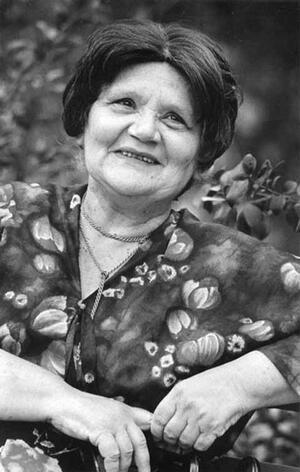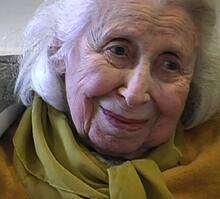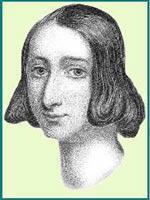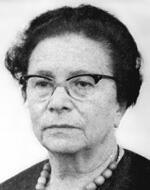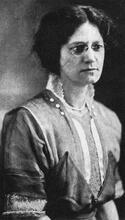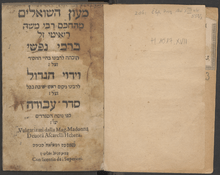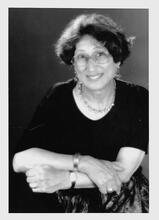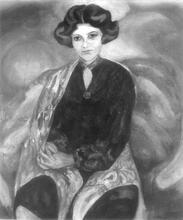Zelda
Born in Russia, Zelda Schneurson Mishkovsky – known to her readers simply as Zelda – immigrated to Palestine in 1926 with her family. After she married in 1950, Zelda began to focus more intensely on her writing. Her husband encouraged her to publish, and in 1967 her first books of poems, Penai (Leisure), was released to great acclaim. Zelda was a prolific poet whose work was utterly unique, conforming to no one school of Hebrew poetry. Her six books of mystical-religious verse were bestsellers, demonstrating that, while her poetry frequently referenced classical Jewish texts, it was admired by Jewish Israelis across political and religious spectrums. One of her poems, L’khol Ish Yesh Shem (Each Person Has a Name) has achieved iconic status; it is recited on every Holocaust Memorial Day in Israel.
Religious lyrics infused with a visionary wildness, the poems of Zelda Schneurson Mishkovsky—known to her readers simply as Zelda—are utterly unique, not part of any poetic school in Hebrew letters. So too, the poet herself was unique, in background and in personality, among modern Hebrew writers.
Family & Early Life
The daughter and granddaughter of prominent hasidic rabbis from the Habad dynasty, Zelda was an only child, born in Russia in 1914. When she was twelve, she immigrated with her family to Palestine where, shortly thereafter, her father and grandfather died. In Jerusalem, where the family had settled, Zelda attended a school for religious girls and later a teachers’ college. It was during her years at the college that she began to write and publish poetry.
At the age of eighteen Zelda moved with her mother to Tel Aviv, where she took private painting lessons and befriended other young artists. When her mother remarried and relocated to Haifa in 1933, Zelda once again accompanied her. In Haifa she developed a love for the landscape of Mount Carmel, to which she paid homage in many poems.
Zelda left her mother’s home for the first and only time in 1935, to pursue her dream of studying painting at the Bezalel Art Academy in Jerusalem. She worked as a housepainter to earn money, but jobs were scarce and she was unable to save enough for tuition. When her mother became ill, she returned to Haifa to care for her, never having had the chance to study art formally. She continued to paint on her own, however, and to write poetry and teach in an elementary school.
Publications & Personal Life
In the early 1940s, after her mother was widowed again, the two women returned to Jerusalem, this time to stay. They settled in a small, dilapidated, ground-floor apartment in the religiously mixed neighborhood of Kerem Avraham (which later became part of Geulah), where Zelda taught school until 1950. That year, at age thirty-six, she married Hayyim Aryeh Mishkovsky, and the couple made their home with Zelda’s mother in the Kerem Avraham flat. It was there that Zelda ministered to her mother until her death in 1965 and also cared for Hayyim, who fell ill shortly after their marriage.
Once married, Zelda gave up teaching and began writing more prolifically and intensely. Hayyim encouraged her to publish, and in 1967 her first book of poems, Penai (Leisure), was released to great acclaim. Dedicated to her father and mother, it contained many poems about them and about her childhood. Her second book, Ha-Karmel ha-I-Nir’eh (The Invisible Carmel), was published shortly after Hayyim died, in 1971, and was dedicated to him. It was followed by four more volumes, each of them a critical and popular success: Al Tirhak (Be Not Far, 1974), Ha-Lo Har Ha-Lo Esh (Surely a Mountain, Surely Fire, 1977), Ha-Shoni ha-Marhiv (The Spectacular Difference, 1981), and She-Nivdelu mi-Kol Merhak (Beyond All Distance, 1984). Hayyim’s death was devastating to Zelda and the later books include many poems to him, giving voice to the deep sorrow and grief that remained with her until the end of her life. Especially poignant are the lyrics in which she calls out to her beloved across a chasm of silence to reach him in “the hidden world.”
Five years after she was widowed, Zelda left Geulah, which had become increasingly religious and insular, and moved to a street on the border between the Orthodox area known as Sha’arei Hesed and the religiously mixed neighborhood of Rehaviah. Situated at the boundary between two worlds, Zelda’s new location was more open to the many nonreligious friends who were among her frequent guests. The change proved felicitous in another way as well: the new apartment let in more daylight, which, as the poems reveal, was a healing presence for her.
Zelda and Hayyim had no children, but after Hayyim’s death Zelda began taking in boarders—young women, often students, whom she treated like daughters. She was extremely devoted to these companions, as they were to her, and supported them financially and in many other ways, even providing them with wedding celebrations. During her last years, when she suffered from cancer, she was surrounded by these women and their families, as well as by her many other friends. Her final book, completed not long before her death in 1984, was dedicated to “the friends of my soul.”
The Popular Appeal of Zelda’s Poetry
Although she lived her entire life within the strictures of ultra-Orthodoxy—dressing modestly and, once married, donning a wig—Zelda’s admirers came from many corners of the heterogeneous (and predominantly secular) Israeli society. Her six books of mystical-religious verse were bestsellers, meriting multiple reprintings and garnering numerous literary awards, including the prestigious Bialik and Brenner Prizes. Kibbutzniks, yeshivah students, academics and soldiers—people of all ages, religious orientations and political persuasions—were among her avid fans. As the popularity of her poetry grew, visitors flocked to her doorstep; her photograph appeared often in the newspapers; the words of her poems were set to music and sung. One of her poems, L’khol Ish Yesh Shem (“Each Person Has a Name”), ultimately achieved iconic status; it is now recited in Israel on every Holocaust Memorial Day.
The enormous popular appeal of Zelda’s poetry is perhaps the more surprising in light of the fact that not all the poems are easily accessible. In addition to frequent allusions to classical Jewish texts—biblical, Talmudic, midrashic, liturgical, kabbalistic and hasidic—her work abounds in figures that are difficult to locate in external sources. These include vividly depicted elements of nature, such as the strange plant, the golden fish, the enchanted bird, the black rose, the orange butterfly. Like the lyrics of Emily Dickinson, H. D. and William Blake, Zelda’s poems are rife with images at once evocatively sensual and suggestive of a deep spirituality, images that have great symbolic resonance within the poet’s oeuvre but are not necessarily rooted outside of it. The highly personal meanings attached to such symbols are often difficult to penetrate.
Use of Hebrew Language
Zelda’s work presents other challenges as well: her erratic, mostly minimal use of punctuation creates a plethora of ambiguities; her line breaks, which tend to follow no pattern, are unreliable keys to syntax or meaning; her frequent shifts of tenses in the middle of sentences can make for dizzying narration. And this is not to mention the challenges of the words themselves—or, more precisely, of their unusual, sometimes jarring, pairings and clusterings.
Yet the idiosyncratic nature of Zelda’s language is also responsible for the poems’ brilliance. In his memoir, A Tale of Love and Darkness (2002), the Israeli novelist and essayist Amos Oz (b. 1939), once Zelda’s adoring second-grade pupil, described her language as follows:
A strange, anarchic Hebrew, a Hebrew belonging to stories of the pious and to hasidic tales and folk parables, a Hebrew overflowing with Yiddish, violating every rule, mixing feminine with masculine, present with past, noun with adjective—a sloppy, even muddled Hebrew. But what vitality there was in these stories! When a story was about snow, it seemed written in words of snow. And when it was about fires, the words themselves burned. And what strange, hypnotic sweetness there was in her tales about all kinds of miracles! As though the writer dipped the letters in wine: the words went spinning in the mouth.
And this, too, Oz observed:
Sometimes she placed one ordinary, everyday word next to another, equally routine and common, and suddenly, in their being joined, from the mere fact of their being side by side, two completely ordinary words unaccustomed to standing next to each other—it was as though suddenly an electric current ran between them.
Indeed, if we read poetry to encounter wonder, Zelda’s words give us more than we could hope for; if the experience catches us off guard, that is simply part of the adventure. Hers are poems that take us places, take us away; poems that go to the edge—and then some. And yet they are never put-ons, never show-offs, and, above all, never artificial: they are not “made” but seem, rather, to have been born whole and delivered to us in a single breath. These qualities surely account, at least in part, for the fact that Zelda’s oeuvre has had such a profound impact on Israeli society, an impact that is arguably as great as that of any Hebrew poetry in the latter half of the twentieth century.
Legacy
Zelda’s reputation has only increased since her death, and today she is also appreciated beyond the borders of Israel. Her poems have appeared in translation in many journals and anthologies, and in 2004 the first book of her poems in English translation was published: The Spectacular Difference: Selected Poems of Zelda (trans. Marcia Falk). Responding to this collection, Academy of American Poets Distinguished Poetry Award Winner Li-Young Lee remarked, “Zelda’s poems as given to us in Marcia Falk’s fine translations are wondrous, magical.”
Selected Works by Zelda
Zelda. Shirey Zelda (The Poems of Zelda). Tel Aviv: Hakibbutz Hameuchad Publishing House Ltd., 1985. [A compilation of the poet’s six books.]
Falk, Marcia, trans. The Spectacular Difference: Selected Poems of Zelda. Cincinnati: Hebrew Union College Press, 2004. [Eighty-two poems, in Hebrew and in English translation (on facing pages), selected from all six of the poet’s books. Includes a two-part Translator’s Introduction and twenty pages of notes providing sources for allusions to classical Jewish texts.]
Bar-Yosef, Hamutal. Al Shirat Zelda (On the Poetry of Zelda). Tel Aviv: Hakibbutz Hameuchad Publishing House Ltd., 1988. [Includes a bibliography of other Hebrew works on Zelda.]
Falk, Marcia. “Strange Plant: Nature and Spirituality in the Poetry of Zelda: A Translator’s Reading.” Religious & Literature 23, no. 3 (Autumn 1991), 97-108.
Kann, Nitsa. “A Boat of Light: Zoharic Images in Zelda’s Poetry.” Nashim: A Journal of Jewish Women’s Studies & Gender Issues 19 (Spring 2010): 64-95.
Oz, Amos. Sippur al Ahavah ve-Hoshekh (A Tale of Love and Darkness). Jerusalem: Keter, 2002, 334, 337. [Quoted excerpts translated by Marcia Falk.]

